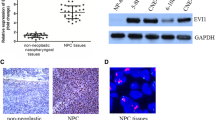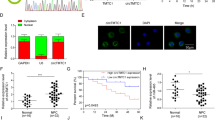Abstract
EIF4E is the rate-limiting factor in the mRNA translation of specific set of oncogenes. Snail is the core transcription factor of epithelial-mesenchymal transition (EMT), a key step of cancer metastasis. The connection between the two oncoproteins has not been well established in the human cancer tissues and in nasopharyngeal carcinoma (NPC). Here we showed that the positive correlative over-expression was seen between eIF4E and Snail in NPC tissues, and the expression was significantly higher in the metastatic NPC than in the un-metastatic NPC. In NPC cells, eIF4E knockdown significantly reduced Snail mRNA and protein levels, increased the mRNA level of E-cad (a direct downstream gene of Snail and a negative EMT marker), attenuated the invasive ability of the cells, and sensitized the cells to cisplatin in invasion. In contrast, enforced the expression of eIF4E significantly increased Snail mRNA and protein levels, and promoted the invasive ability in NPC cells. Under the condition of the high eIF4E expression, Snail knockdown significantly increased E-cad mRNA level and weaken the invasive ability of NPC cells. Finally, eIF4E directly bound Snail mRNA for translation initiation displayed by the RIP assay. Therefore, the results firstly suggested that eIF4E enhanced the Snail expression in both transcription and translation manner in human cancer tissues and targeting the eIF4E/Snail axis might intervene with the EMT and metastasis of NPC. This finding provided a new clue for further understanding the metastatic mechanism of human cancers and for preventing and treating NPC metastasis.







Similar content being viewed by others
References
Shair KHY, Reddy A, Cooper VS (2018) New insights from elucidating the role of LMP1 in nasopharyngeal carcinoma. Cancers (Basel) 10(4)
Zheng W, Zong J, Huang C, Chen J, Wu J, Chen C, Lin S, Pan J (2016) Multimodality treatment may improve the survival rate of patients with metastatic nasopharyngeal carcinoma with good performance status. PLoS One 11(1):e0146771
Mittal V (2018) Epithelial mesenchymal transition in tumor metastasis. Annu Rev Pathol 13:395–412
Zuo LL, Zhang J, Liu LZ, Zhou Q, Du SJ, Xin SY, Ning ZP, Yang J, Yu HB, Yue WX, Wang J, Zhu FX, Li GY, Lu JH (2017) Cadherin 6 is activated by Epstein-Barr virus LMP1 to mediate EMT and metastasis as an interplay node of multiple pathways in nasopharyngeal carcinoma. Oncogenesis 6(12):402
Brzozowa M, Michalski M, Wyrobiec G, Piecuch A, Dittfeld A, Harabin-Słowińska M, Boroń D, Wojnicz R (2015) The role of Snail1 transcription factor in colorectal cancer progression and metastasis. Contemp Oncol (Pozn) 19(4):265–270
Yu H, Shen Y, Hong J, Xia Q, Zhou F, Liu X (2015) The contribution of TGF-β in epithelial-mesenchymal transition (EMT): down-regulation of E-cadherin via snail. Neoplasma 62(1):1–15
Ren X, Yang X, Cheng B, Chen X, Zhang T, He Q, Li B, Li Y, Tang X, Wen X, Zhong Q, Kang T, Zeng M, Liu N, Ma J (2017) HOPX hypermethylation promotes metastasis via activating snail transcription in nasopharyngeal carcinoma. Nat Commun 8:14053
Horikawa T, Yoshizaki T, Kondo S, Furukawa M, Kaizaki Y, Pagano JS (2011) Epstein-Barr virus latent membrane protein 1 induces snail and epithelial-mesenchymal transition in metastatic nasopharyngeal carcinoma. Br J Cancer 104(7):1160–1167
Gingras AC, Raught B, Sonenberg N (1999) EIF4 initiation factors: effectors of mRNA recruitment to ribosomes and regulators of translation. Annu Rev Biochem 68:913–963
Ernst BP, Mikstas C, Stöver T, Stauber R, Strieth S (2018) Association of eIF4E and SPARC expression with lymphangiogenesis and lymph node metastasis in hypopharyngeal cancer. Anticancer Res 38(2):699–706
Oblinger JL, Burns SS, Huang J, Pan L, Ren Y, Shen R, Kinghorn AD, Welling DB, Chang LS (2018) Overexpression of eIF4F components in meningiomas and suppression of meningioma cell growth by inhibiting translation initiation. Exp Neurol 299(Pt B):299–307
Liang S, Guo R, Zhang Z, Liu D, Xu H, Xu Z, Wang X, Yang L (2013) Upregulation of the eIF4E signaling pathway contributes to the progression of gastric cancer, and targeting eIF4E by perifosine inhibits cell growth. Oncol Rep 29(6):2422–2430
Wang S, Pang TY, Gao M, Kang HX, Ding WB, Sun XW, Zhao Y, Zhu W, Tang XD, Yao YH, Hu XR (2013) HPV E6 induces eIF4E transcription to promote the proliferation and migration of cervical cancer. FEBS Lett 587(6):690–697
Wu MY, Liu YX, Di XQ, Hu XR (2013) EIF4E over-expresses and enhances cell proliferation and cell cycle progression in nasopharyngeal carcinoma. Med Oncol 30:400
Zhao Y, Pang TY, Wang Y, Wang S, Kang HX, Ding WB, Yong WW, Bie YH, Cheng XG, Zeng C, Yao YH, Li Q, Hu XR (2014) LMP1 stimulates the transcription of eIF4E to promote the proliferation, migration and invasion of human nasopharyngeal carcinoma. FEBS J 281(13):3004–3018
Wang W, Wen Q, Luo J, Chu S, Chen L, Xu L, Zang H, Alnemah MM, Li J, Zhou J, Fan S (2017) Suppression of β-catenin nuclear translocation by CGP57380 decelerates poor progression and potentiates radiation-induced apoptosis in nasopharyngeal carcinoma. Theranostics 7(7):2134–2149
Zheng J, Li J, Xu L, Xie G, Wen Q, Luo J, Li D, Huang D, Fan S (2014) Phosphorylated Mnk1 and eIF4E are associated with lymph node metastasis and poor prognosis of nasopharyngeal carcinoma. PLoS One 9(2):e89220
Zheng J, Zhang C, Zhang Y, Pei J, Fan S (2017) Over-expressions of p-eIF4E and p-4EBP1 are associated with poor prognosis in nasopharyngeal carcinoma. Xi Bao Yu Fen Zi Mian Yi Xue Za Zhi 33(4):531–535
Zhang P, Wu SK, Wang Y, Fan ZX, Li CR, Feng M, Xu P, Wang WD, Lang JY (2015) p53, MDM2, eIF4E and EGFR expression in nasopharyngeal carcinoma and their correlation with clinicopathological characteristics and prognosis: a retrospective study. Oncol Lett 9(1):113–118
Robichaud N, Del Rincon SV, Huor B, Alain T, Petruccelli LA, Hearnden J, Goncalves C, Grotegut S, Spruck CH, Furic L, Larsson O, Muller WJ, Miller WH, Sonenberg N (2015) Phosphorylation of eIF4E promotes EMT and metastasis via translational control of SNAIL and MMP-3. Oncogene 34(16):2032–2042
Smith KA, Zhou B, Avdulov S, Benyumov A, Peterson M, Liu Y, Okon A, Hergert P, Braziunas J, Wagner CR, Borok Z, Bitterman PB (2015) Transforming growth factor-β1 induced epithelial mesenchymal transition is blocked by a chemical antagonist of translation factor eIF4E. Sci Rep 5:18233
Liu M, Peng P, Wang J, Wang L, Duan F, Jia D, Ruan Y (2015) Gu J.RACK1-mediated translation control promotes liver fibrogenesis. Biochem Biophys Res Commun 463(3):255–261
Kwegyir-Afful AK, Bruno RD, Purushottamachar P, Murigi FN, Njar VC (2016) Galeterone and VNPT55 disrupt Mnk-eIF4E to inhibit prostate cancer cell migration and invasion. FEBS J 283(21):3898–3918
Ramamurthy VP, Ramalingam S, Gediya LK, Njar VCO (2018) The retinamide VNLG-152 inhibits f-AR/AR-V7 and MNK-eIF4E signaling pathways to suppress EMT and castration-resistant prostate cancer xenograft growth. FEBS J 285(6):1051–1063
Tajirika T, Tokumaru Y, Taniguchi K, Sugito N, Matsuhashi N, Futamura M, Yanagihara K, Akao Y, Yoshida K. DEAD-box protein RNA-helicase DDX6 regulates the expression of HER2 and FGFR2 at the post-transcriptional step in gastric cancer cells. Int J Mol Sci. 2018; 19(7). pii: E2005
Decarlo L, Mestel C, Barcellos-Hoff MH, Schneider RJ (2015) Eukaryotic translation initiation factor 4E is a feed-forward translational coactivator of transforming growth factor β early protransforming events in breast epithelial cells. Mol Cell Biol 35(15):2597–2609
Dodd KM, Yang J, Shen MH, Sampson JR, Tee AR (2015) mTORC1 drives HIF-1α and VEGF-A signalling via multiple mechanisms involving 4E-BP1, S6K1 and STAT3. Oncogene 34(17):2239–2250
Herdy B, Jaramillo M, Svitkin YV, Rosenfeld AB, Kobayashi M, Walsh D, Alain T, Sean P, Robichaud N, Topisirovic I, Furic L, Dowling RJO, Sylvestre A, Rong L, Colina R, Costa-Mattioli M, Fritz JH, Olivier M, Brown E, Mohr I, Sonenberg N (2012) Translational control of the activation of transcription factor NF-κB and production of type I interferon by phosphorylation of the translation factor eIF4E. Nat Immunol 13(6):543–550
Mali AV, Joshi AA, Hegde MV, Kadam SS (2018) Enterolactone modulates the ERK/NF-κB/snail signaling pathway in triple-negative breast cancer cell line MDA-MB-231 to revert the TGF-β-induced epithelial-mesenchymal transition. Cancer Biol Med 15(2):137–156
Jeong BY, Cho KH, Jeong KJ, Park YY, Kim JM, Rha SY, Park CG, Mills GB, Cheong JH, Lee HY (2018) Rab25 augments cancer cell invasiveness through a β1 integrin/EGFR/VEGF-A/snail signaling axis and expression of fascin. Exp Mol Med 50(1):e435
Lin X, Sun R, Zhao X, Zhu D, Zhao X, Gu Q, Dong X, Zhang D, Zhang Y, Li Y, Sun B (2017) C-myc overexpression drives melanoma metastasis by promoting vasculogenic mimicry via c-myc/snail/Bax signaling. J Mol Med (Berl) 95(1):53–67
Zhai D, Cui C, Xie L, Cai L, Yu J (2018) Sterol regulatory element-binding protein 1 cooperates with c-Myc to promote epithelial-mesenchymal transition in colorectal cancer. Oncol Lett 15(4):5959–5965
Song R, Song H, Liang Y, Yin D, Zhang H, Zheng T, Wang J, Lu Z, Song X, Pei T, Qin Y, Li Y, Xie C, Sun B, Shi H, Li S, Meng X, Yang G, Pan S, Zhu J, Qi S, Jiang H, Zhang Z, Liu L (2014) Reciprocal activation between ATPase inhibitory factor 1 and NF-κB drives hepatocellular carcinoma angiogenesis and metastasis. Hepatology 60(5):1659–1673
Wanami LS, Chen HY, Peiró S (2008) García de Herreros a, Bachelder RE. Vascular endothelial growth factor-a stimulates snail expression in breast tumor cells: implications for tumor progression. Exp Cell Res 314(13):2448–2453
Moon H, Ju HL, Chung SI, Cho KJ, Eun JW, Nam SW, Han KH, Calvisi DF, Ro SW (2017) Transforming growth factor-β promotes liver tumorigenesis in mice via up-regulation of snail. Gastroenterology 153(5):1378–1391
Evdokimova V, Tognon C, Ng T, Ruzanov P, Melnyk N, Fink D, Sorokin A, Ovchinnikov LP, Davicioni E, Triche TJ, Sorensen PH (2009) Translational activation of Snail1 and other developmentally regulated transcription factors by YB-1 promotes an epithelial-mesenchymal transition. Cancer Cell 15:402–415
Acknowledgements
This work was funded by the Natural Science Fund of Guangdong Province (2015A030313519), the National Natural Science Fund of China (81572566) and the Science and Technology Planning Project of Guangdong Province (2016A020215146).
Author information
Authors and Affiliations
Corresponding author
Ethics declarations
Conflict of Interest
Authors Yunhong Yao, Tianyun Pang, Ying Cheng, Weiwei Yong, Haixian Kang, Yi Zhao, Sen Wang and Xinrong Hu declare that they have no conflict of interest.
Additional information
Publisher’s Note
Springer Nature remains neutral with regard to jurisdictional claims in published maps and institutional affiliations.
Rights and permissions
About this article
Cite this article
Yao, Y., Pang, T., Cheng, Y. et al. Positive Correlative over-Expression between eIF4E and Snail in Nasopharyngeal Carcinoma Promotes its Metastasis and Resistance to Cisplatin. Pathol. Oncol. Res. 26, 1639–1649 (2020). https://doi.org/10.1007/s12253-019-00733-x
Received:
Accepted:
Published:
Issue Date:
DOI: https://doi.org/10.1007/s12253-019-00733-x




